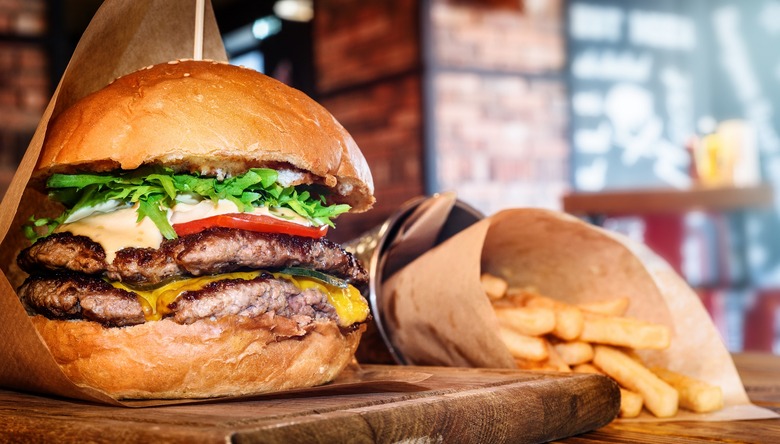Nonprofit Reveals The Most 'Xtreme' High-Calorie Restaurant Dishes
At the Center for Science in the Public Interest (CSPI), judges of nominees for the annual "Xtreme Eating Awards" have one mission: To protect the general population from explosive, health-endangering restaurant meals.
According to CSPI, restaurants have officially taken things too far. Due to the Trump administration's rollback of an Obama-era initiative requiring that menus publish nutritional information, the real calorie impact of many dishes remains unseen. But when breakfast options tallied up to almost an entire day's worth of fatty, cheesy calories, the men and women at this nonprofit organization decided it was well past time to intervene. They're putting it all out on the table — and warning you to keep these meals off of yours.
Not only have they singled out individual dishes for reprimands, they've awarded Domino's with an "Xtreme Putting Profits Before Health Award" for their efforts to lobby against the mutritional information rules. "Who cares about the obesity and diabetes epidemics, as long as the cash keeps rolling in to one of the nation's premier purveyors of white flour and cheese?" the organization's website chides scathingly.
Fast-food restaurants are of course prime contenders on the organization's list of calorie-offenders, but they're not the only transgressors hiding a shocking nutritional upset. The counts are in, and these are this year's Xtreme Eating Awards.
Worst Visceral Effects: Chili's Ultimate Steakhouse Combo
Calories: 2,440
Least Original Breakfast: IHOP Cheeseburger Omelette With Pancakes, Butter, and Syrup
Calories: 1,990
Worst Adapted Pasta: The Cheesecake Factory Pasta Napoletana
Calories: 2,310
Worst Cheese in a Leading Role: Buffalo Wild Wings Cheese Curd Bacon Burger With Fries
Calories: 1,950
Worst Original Appetizer: Dave & Buster's Carnivore Pizzadilla
Calories: 1,970
Most Damage From a Supporting Vegetable: Texas Roadhouse 16 oz. Prime Rib, Loaded Sweet Potato, Caesar Salad
Calories: 2,820
Worst Cocktail Design: The Cheesecake Factory Flying Gorilla
Calories: 950
Most Ridiculous Ending: Uno Pizzeria & Grill Ridiculously Awesome, Insanely Large Chocolate Cake
Calories: 1,740
Here's the thing, though. No one's buying an alcoholic, Flying Gorilla milkshake with the intention of sipping on something slimming. Despite the fact that restaurants are selling these items, they aren't instructing or advising consumers to eat the entire meal in one sitting, or to eat these meals every day.
This list, along with other critical takes on indulgent restaurant offerings, calls to mind a controversial health debate: Is it morally wrong for restaurants to sell high-calorie, indulgent meals, or is it perfectly okay to allow consumers to make their own responsible choices?
Attendees of these restaurants have complete autonomy over their orders and their decisions. Yet many organizations continue to pressure restaurants to impose exclusively "healthy" lower-calorie meals and, essentially, diets on consumers.
Occasional indulgence is not only exhibited as a perfectly healthy part of the average person's diet, but is actually beneficial to health outcomes. Nyree Dardarian, director of the Center for Integrated Nutrition and Performance Coordination at Drexel University advised readers of Time to indulge occasionally. "When you put rules and restrictions on something, you're only going to want it more," she says. Diets and recommendations to limit dessert to just once a week or on special occasions often fail — and this is exactly why.
So are governmental regulations and diet-police organizations like the CSPI really the answer? Restrictions and limits on indulgent foods often backfire, resulting in poorer health outcomes in the long run. Judging from the real science — rather than the fear-based, emotional messaging distributed by this organization — putting America on a diet might not be the solution we're looking for to the public health crisis.








